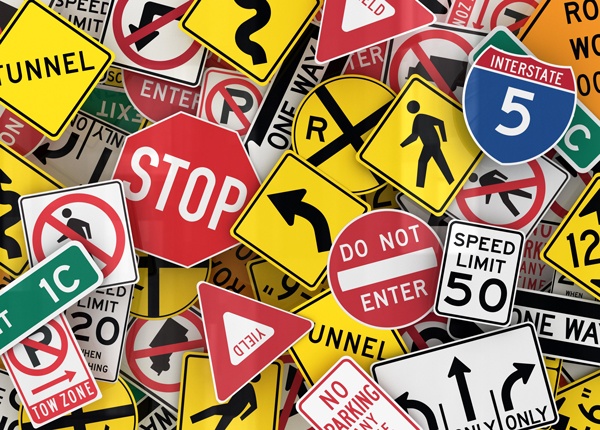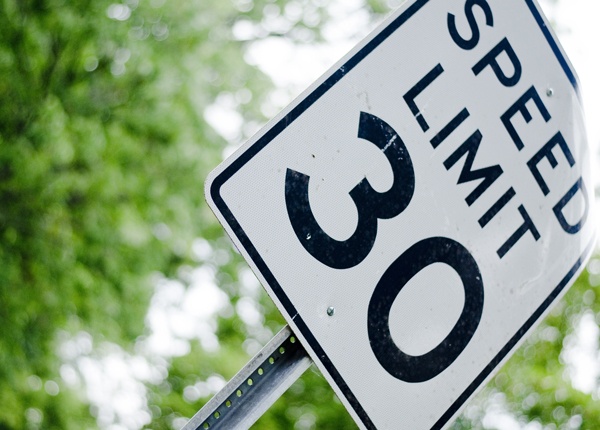
Signs, Signals and Markings: Knowing Traffic Control Devices
Updated Oct. 20, 2020Road signs, traffic signals and pavement markings are crucial topics in your driver’s ed program. Your knowledge of these traffic control devices will be assessed during the learner’s permit test and will ensure you can drive on our nation’s roadways safely, while abiding by the rules of the road. This section contains essential information about signs, signals and markings and should be used to support your learning, alongside your state’s official driving manual.
Traffic control devices
Road signs, traffic lights and road markings are types of traffic control devices, as they guide traffic, reinforce road law and issue essential instructions about mandatory and prohibited actions. The warnings and road rules communicated by traffic control devices have been carefully designed to keep traffic moving in an orderly fashion and maximize public safety.
Traffic control devices are everywhere. Think how many hundreds of road signs, signal lights and pavement markings you will encounter on just a 10-minute round-trip from your home! Each type of traffic control device conveys a unique message to road users and as a student driver, you must learn how to interpret those messages.
Uniformity in traffic control devices
Fortunately, a standard has been established for the shapes, colors and symbols used in traffic control devices, making them easy for drivers to understand. Learning these standards is like learning a language. You will soon be able to “read” road signs, traffic signals and pavement markings, just as easily as you read the words on this page.
The design, installation and upkeep of traffic control devices is managed by the Federal Highway Administration. Their Manual on Uniform Traffic Control Devices (MUTCD), details the country-wide standard for road signs, signals and markings. Wherever you drive in the United States, the traffic control devices you encounter will adhere to this standard. This means that visiting a distant city or state does not mean you will have to learn a whole new set of rules.
Obeying traffic control devices
Failure to obey traffic control devices can result in fines, penalties or complete loss of your driver’s license. It would also mean endangering yourself and everybody else on the road. Despite being fully aware of these risks, many drivers still choose to disobey the rules.
You must never assume that other drivers will follow the instructions given by traffic control devices. Public safety depends on all road users exercising caution, at all times – even when a green light or right-of-way rules mean they should be able to proceed without danger.
Check for cross traffic whenever you drive through an intersection and yield the right-of-way to any motorist who disregards a posted road sign or traffic signal. You could be held partially or entirely responsible for any injury or property damage that results from you forcibly claiming the right-of-way.
Road signs
There are hundreds of different road signs in common use around the United States, and hundreds more which you may only encounter on rare occasions. For the most part, road signs in every state adhere to a nationwide standard. Though, it is important to keep in mind that many states use some of their own local road sign designs in addition to those laid out in the Federal Highway Administration’s MUTCD.
The general meaning of a road sign can be determined by its color and shape. These factors tell motorists what “type” of road sign they are dealing with and whether any immediate action is required. For instance, whether they must stop or be prepared to encounter a hazard. Our comprehensive exploration of road sign designs and meanings discusses:
- Road sign categories
- Unique road signs
- How to recognize road signs by color and shape
- State-specific road sign designs
Traffic signals
Traffic lights are implemented on any piece of roadway where fixed road signs cannot manage traffic alone. This would be the case where conditions are changeable, for instance:
- At railroad crossings, where trains only pass through a few times a day.
- On a road where the direction of traffic is sometimes changed.
- At drawbridges, which can be lifted and closed to motorists.
Of course, traffic lights are encountered at controlled intersections far more frequently than they are in other settings. Thanks to red, yellow and green signals lights, large volumes of traffic can move through complex intersections in a safe and orderly manner. Motorists must understand why different types of traffic signals are installed and how they work, in order to adjust their driving behavior appropriately. It is not simply a matter of “red means stop” or “green means go”.
Pavement markings
An array of painted lines, patterns, letters and symbols adorn every major roadway around the country. Pavement markings are often used in conjunction with traffic lights or road signs to support the information they convey. For example, you may encounter the word “SLOW” painted on the road’s surface, when low-speed limit signs or school zone signs are posted nearby.
Of course, the meaning behind many pavement markings is not so immediately obvious. How should you interpret a broken yellow line in the center of the roadway, or a solid white line at the road’s edge? What do triangles and white, slanted lines mean? Find the answers to these questions – and many more – in this collection of articles. We deal with each type of road marking separately, starting with standard pavement lines.
People directing traffic
Drivers may only ignore posted road signs, traffic lights and pavement markings when an authorized traffic control operative is present in the roadway and issues them with instructions that contradict those devices. Ignoring signs and signals is not only permissible under such circumstances – it is required by law. Traffic control personnel are only assigned to direct traffic when the conditions on a roadway have changed to create an unsafe environment.
Motorists must follow all instructions given to them by police officers, flaggers, crossing guards and other authorized traffic control persons. Encountering traffic control personnel is quite uncommon, which means that many drivers are not sure how to behave when they find themselves in such circumstances. Any confusion you may have about people directing traffic will be cleared up with the information in this module.




